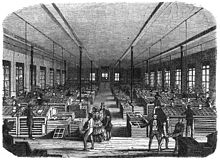Typesetting
The typesetting is a workshop, as part of a printing or as an independent operation, the production of record executing.
Facility

The typesetting is the typesetter's workplace. The largest room in the typesetting is the typesetting room, or later the machine room, in which the typesetter's workplace is located. Storage rooms or a foundry can also be connected to these.
Working method
The typesetter receives a manuscript from which a finished template for the printing process is created through the work in the typesetting . The printing form can be produced in various processes.
The oldest method is lead type made by hand . In the typesetting shop, the fonts required for this are also stored in so-called type boxes on type shelves . The machine set required fewer shelves to store fonts because the machines could cast the set from reusable dies . The process used later was photo typesetting , before the nature of the manufacturing process changed significantly with the introduction of desktop publishing .
Historical
In 1998 the independent job description of the typesetter disappeared in Germany, it was united with that of the reprographic . The official name was initially "Media designer for digital and print media", since 2007 it has been " Media designer for digital and print ".
Composers were also known among those employed there for the endemic occurrence of the (fictitious) lead lice .
various
- The Museum of Printing Art in Leipzig presents the lead type.
swell
- Severin Corsten, Stephan Füssel et al. (Hrsg.): Lexicon of the entire book system . Volume 7 (Delivery 49). Anton Hiersemann, Stuttgart 2004, ISBN 3-7772-0412-9 .
- Helmut Hiller, Stephan Füssel: Dictionary of the book . 7th edition. Vittorio Klostermann, Frankfurt 2006. ISBN 3-465-03495-3 .